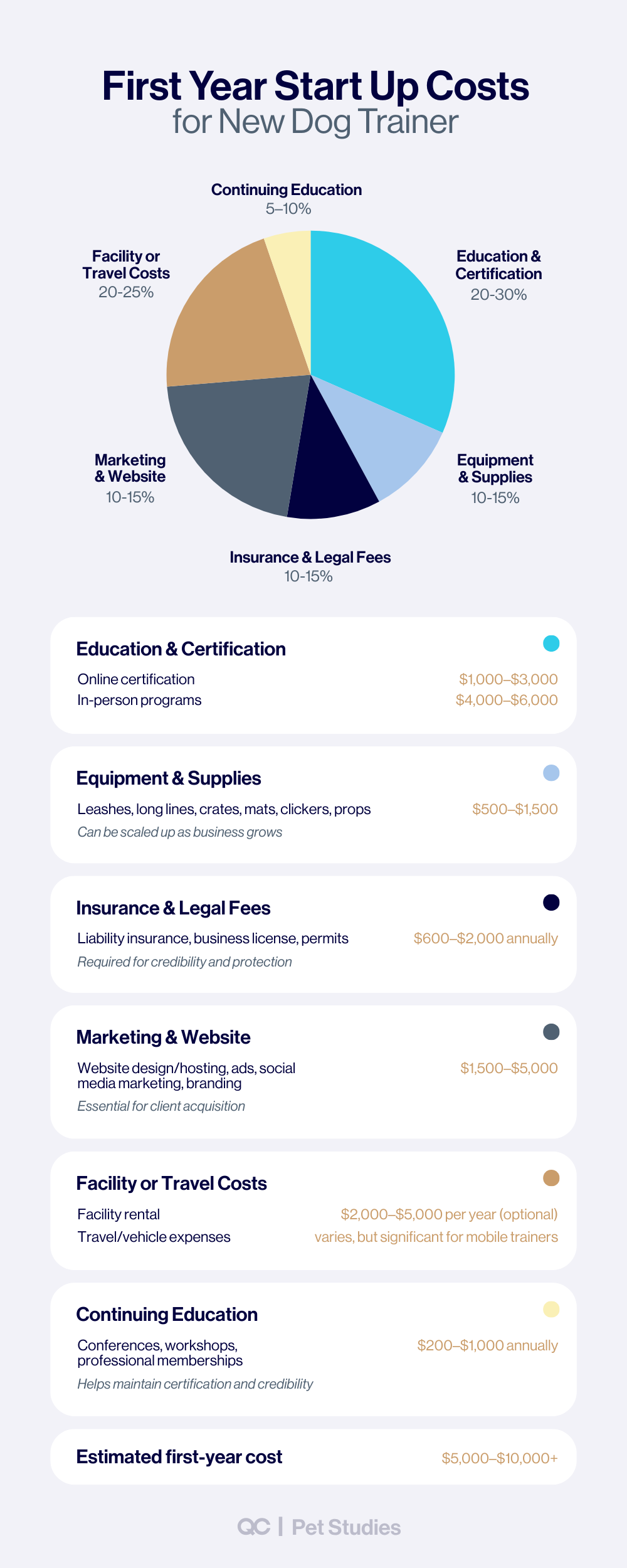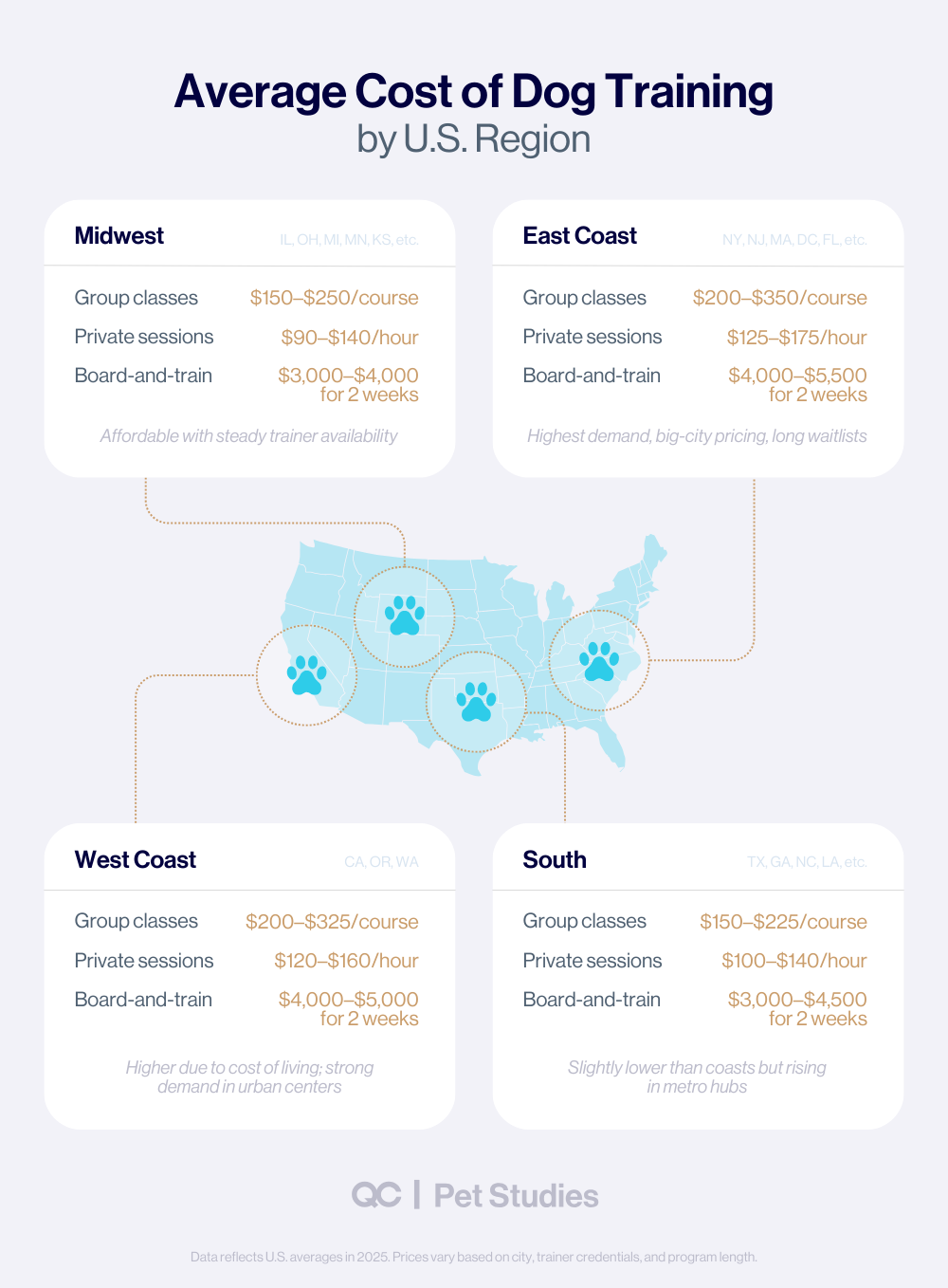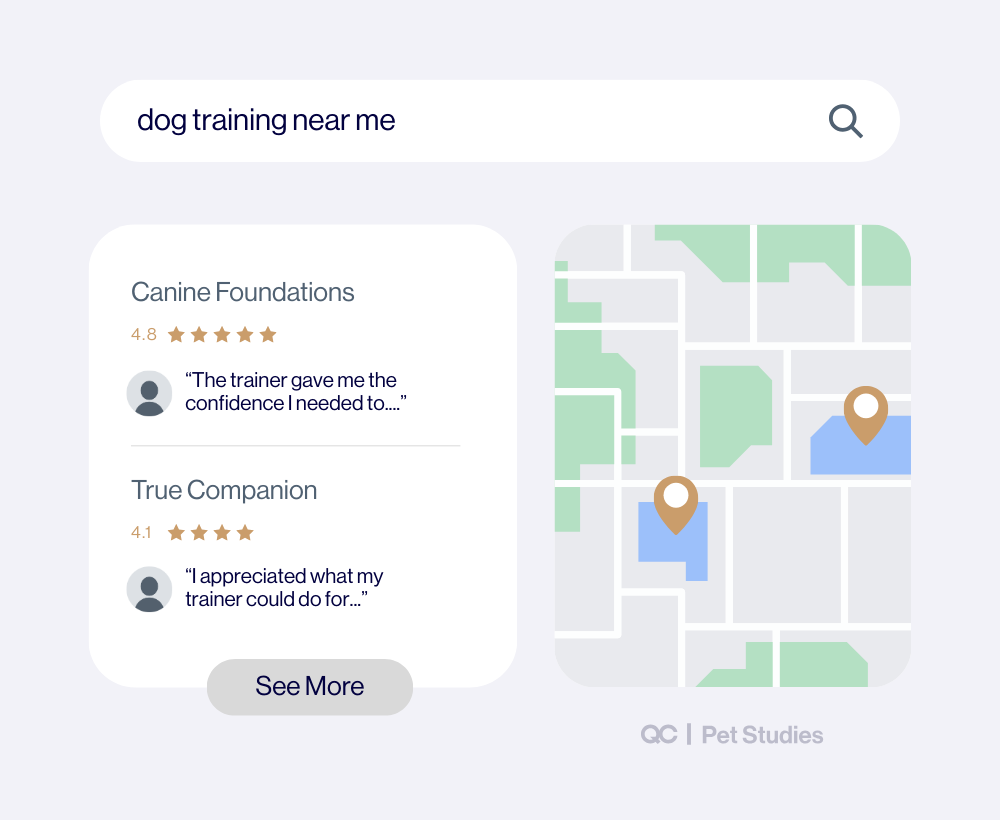How Much Is Dog Training: Key Points
- Group classes cost $150–$300; private lessons $100–$150/hr.
- Specialty training (service, guard, therapy) costs far more.
- Location, trainer credentials, and dog needs affect price.
- Hidden costs include gear, travel, and refresher sessions.
- Startup costs for becoming a dog trainer are modest compared to many careers.
Introduction
Training a dog is one of the most valuable investments a person can make. But when people ask, “How much is dog training?,” the answer depends on two perspectives: (1) the pet owner looking to hire a trainer, and (2) the aspiring trainer preparing to launch a career. This article explores both, giving you the most comprehensive look at costs on the internet.
So, keep reading to discover how much dog training really is, from what trainers invest to start their careers to what clients pay. To make this easier, we’ll first look at all the costs and investments aspiring professional dog trainers should expect. Then, we’ll switch to the client’s perspective to explore what dog owners pay for training services.
Dog owners aren’t the only ones thinking about price. For aspiring trainers, building a career also comes with costs, too. Education, tools, and business expenses are part of getting started. Here’s a breakdown of what new trainers should expect to budget for.
Education and Certification ($1,000–$6,000)
Becoming a professional trainer starts with the right education—and you have a handful of options at your disposal!
- Online certification programs: $1,000–$3,000
- In-person schools or academies: $4,000–$6,000 (plus travel/housing)
- Specialized courses (e.g., service dog or behavior work) can cost more.
- Most certifications require continuing education to stay valid.
Startup Equipment & Supplies ($500–$1,500)
Trainers also need gear for classes, private sessions, and demos. Here are some recommended products:
- Clickers, treat pouches, training treats: $50–$150
- Leashes, harnesses, long lines: $100–$250
- Crates, mats, or training props: $200–$400
- Liability insurance (often required): $300–$600 annually
- Marketing basics (business cards, flyers, website domain): $100–$200
It’s totally okay to start small and add equipment as your business grows. Keep in mind, too, that clients will also often provide their own gear during lessons.
First-Year Business Expenses ($5,000–$10,000+)
That said, launching a training business goes beyond supplies. Here’s what you can realistically expect to spend on legal, marketing, and client-building essentials as a professional dog trainer within your first 12 months of business operations:

Continuing Education and Development ($200–$1,000 annually)
A good dog trainer NEVER stops learning. Ongoing development helps build credibility and attract clients. Thus, throughout your career, you’ll likely attend things like:
- Workshops and seminars: $200–$500 per year
- Professional memberships (APDT, IAABC, CCPDT): $100–$200 annually
- Conferences and advanced certifications: $500–$1,000
- Online learning platforms or webinars: $50–$150 each
- Staying current ensures you can charge competitive rates.
How to Find Dog Training Courses Near Me (As an Aspiring Trainer)
If you’re looking to become a professional trainer, you’ve probably searched “how much is dog training near me” or even “how to find dog training courses near me”. The truth is, there are many options. However, not all will set you up for success.
So, here’s how to find the right program for your career goals…
Research Accredited Schools and Programs
Start by looking for schools that are recognized in the industry.
- Look for programs that include personalized tutor feedback, hands-on work, networking opportunities, and continuing education.
- Compare tuition ranges: $1,000–$3,000 online vs. $4,000–$6,000 in person.
- Check reviews from past students to see what real-life grads thought of their training experience.
- Make sure the school’s methods are rooted in positive reinforcement.
(Psst! QC Pet Studies checks all of these boxes—plus so much more!)
Start Your Career in Dog Training
Earn your dog trainer certification in as little as 3 months!
Ask About Flexibility and Location
Not everyone can relocate or quit their job to attend school. One major downside of many brick-and-mortar schools is that they require in-person attendance, which adds housing and travel costs. If you’re someone with a busy schedule (e.g., a parent, working full-time, etc.), this inflexible type of learning structure might not work for you.
Online training, on the other hand, offers flexibility to study from anywhere! Furthermore, self-paced options allow you to balance education with work or family. Not to mention, it’s often the most cost-effective path, perfect for any kind of budget.
Choosing an online course means your education moves with you, no matter where you live!
Look for Career Support and Networking
The best schools don’t just teach you how to train dogs—they also help you start your business, too.
- Ask if the program provides career services or business modules.
- Networking with instructors and alumni can open doors for job placements.
- Some schools offer lifetime access to resources and updates.
- Business training helps you price services, market yourself, and attract clients.
Is Dog Training Worth the Investment For Aspiring Trainers?
With all these factors in mind, you might wonder if dog training is really worth it—and the answer is yes! Dog training isn’t just a passion; it’s something you can very easily turn into a viable business opportunity. There are many reasons for this:
- Startup costs are modest compared to other careers.
- Demand for trainers is growing as pet ownership rises.
- Trainers can set their own rates and scale their business.
- Building a client base means steady income and repeat customers.
- Specialized skills (e.g., service or behavioral training) allow higher earnings.
Ultimately, becoming a professional dog trainer offers more than financial return. It gives you the joy of improving lives, both human and canine!
The Average Cost of Dog Training Services (For Dog Owners)
Now let’s turn our focus to the other side of things: the cost of dog training for actual pet owners.
When most people ask, “how much is dog training?”, they’re thinking about the standard options: group classes, private lessons, puppy training, or board-and-train programs. Each option has different benefits and price points. Here’s what you can expect to pay…
Group Dog Training Classes ($150–$300 per course)
For starters, group classes are one of the most popular options for basic obedience. They are affordable, social, and a great way for dogs to learn in a distracting environment.
- Usually run 4–6 weeks.
- Average price: $150–$300 per course.
- Some puppy classes may cost as low as $55–$125.
- Great for teaching sit, stay, recall, and leash manners.
- Added bonus: dogs get to socialize with people and other dogs.
Private Dog Training Sessions ($100–$150/hour)
Next, private training is the best option for owners who want one-on-one help. Prices for these sessions are higher because you’re paying for direct attention from the trainer.
- Average cost: $100–$150/hour.
- Some highly experienced trainers charge more.
- Great for behavior issues like reactivity, aggression, or anxiety.
- Can be done in-home, at a training center, or virtually.
- Personalized to your dog’s exact needs.

Puppy Training Costs ($50–$125 per class)
Puppy classes are often the first step in a dog’s education. They cover socialization and basic commands.
- Usually last 4–6 weeks.
- Average cost: $50–$125 per class, or $200–$500 per course.
- Focus on house training, crate training, and bite inhibition.
- Important for preventing bad habits before they start.
- Many trainers bundle puppy programs with obedience classes.
Board-and-Train Programs ($3,000–$5,000 for two weeks)
Board-and-train is the most expensive option. Dogs stay with the trainer for an intensive period of learning.
- Typical cost: $3,000–$5,000 for a 2-week stay.
- Some programs go longer and cost more.
- Great for dogs with major behavior problems.
- Owners must be ready to continue training at home afterward.
- Not always the best fit for puppies or anxious dogs.
Specialty Training Costs
Not all dogs need only obedience training. Rather, some require advanced or specialized programs. Because of the skills involved, these services understandably come with higher price tags. Here’s what you can expect.
Service Dog Training ($10,000–$30,000+)
Service dog training is one of the most expensive types of training, since these dogs learn life-saving skills that support people with disabilities.
- Typical range: $10,000–$30,000+ depending on tasks and trainer credentials.
- Covers tasks like guiding, mobility support, PTSD response, and retrieval.
- Training can take 1–2 years to complete.
- Often requires multiple phases: obedience, public access, task-specific work.
- Some nonprofits subsidize costs, but waitlists can be long.
🔖 If you’re curious about working in this rewarding field, be sure to also check out our guide on how to become an emotional support dog trainer for a full breakdown of the career path and training process!
Therapy Dog Training ($2,000–$5,000)
Therapy dogs provide comfort in hospitals, schools, and nursing homes. Their training is less intensive than service dogs but still requires time and money.
- Typical cost: $2,000–$5,000 for complete training.
- Dogs must pass the Canine Good Citizen (CGC) test first.
- Focuses on calm behavior around children, medical equipment, and crowds.
- Certification fees usually add $100–$300.
- Ongoing refresher courses are common ($30–$100 per session).
Guard Dog Training ($5,000–$15,000)
Guard dog training focuses on protection, discipline, safety, and control. These programs require specialized trainers with experience in defense training.
- Price range: $5,000–$15,000 depending on length and trainer expertise.
- Includes obedience, impulse control, and handler protection.
- Dogs must have the right temperament; not all breeds qualify.
- Some programs offer advanced levels (personal protection vs. property guarding).
- Ongoing reinforcement sessions are recommended.
Behavioral Modification ($150–$300 per session)
Behavioral training is for dogs struggling with reactivity, aggression, or anxiety. It’s more expensive than obedience classes because it requires one-on-one work.
- Typical cost: $150–$300 per 90-minute consultation.
- Follow-up sessions often cost $100–$200 each.
- May include separation anxiety programs ($600–$900 per month virtual).
- Highly tailored to each dog’s needs.
- Often requires multiple sessions to see lasting change.
Become a Certified Dog Behavior Specialist
Earn QC’s International Dog Behavior Specialist™ (IDBS™) certification in as little as 12 weeks!
Location (Urban vs. Suburban vs. Rural)
Where you live makes a big difference in training costs! For instance:
- Urban areas (like New York or Los Angeles) can cost 20–40% more than suburban or rural regions.
- Trainers in high-demand metro areas may have waiting lists.
- Suburban prices are usually mid-range.
- Rural areas tend to be cheaper, but trainer availability may be limited.
- Some trainers offer online/virtual sessions to bridge location gaps.
Factors That Influence Dog Training Prices
When people search, “how much is dog training near me”, the answer can vary a lot. After all, several key factors affect how much you (as the dog trainer) may charge, as well as what clients should expect to pay.

Trainer Credentials and Experience
Not all trainers charge the same. Certification and experience play a big role.
- Certified trainers often charge more.
- Trainers with 10+ years of experience may price at the top of the range.
- Specialty trainers (e.g., aggression, service dogs) have higher fees.
- Ongoing education adds credibility and costs.
- Always ask about certifications before enrolling.
So long as you’re not charging far above your local competitors/the going average where you live, a higher hourly rate often reflects proven experience and better results. Moreover, it can save money in the long run.
Dog’s Age, Breed, and Behavioral Needs
Each dog is different. Thus, when it comes to pricing, factors like age, breed, and challenges all come into play, too.
- Puppies need socialization classes, usually cheaper.
- Large breeds may require longer or more intensive sessions.
- Reactive or anxious dogs often need private training, which is costlier.
- Working breeds (Border Collies, German Shepherds) may need advanced training.
- Older rescues sometimes need refresher or behavior modification classes.
Class Length, Packages, and Extras
Lastly, how training is structured can change the final price.
- Most group classes run 4–6 weeks.
- Packages (buy 5, get 1 free) often reduce the per-class cost.
- Board-and-train may include follow-up sessions.
- Refresher courses are sometimes discounted for repeat clients.
- Extra add-ons (training gear, travel fees) can raise total cost.
From The Client’s Side: The Hidden Costs of Dog Training
Class or session fees tell only part of the story. Dog training often comes with extra expenses—some small, some ongoing—that can add up quickly if you’re not prepared. By being aware of these hidden costs, you can budget more realistically and avoid any unwanted surprises.
Training Equipment
Even though dog training doesn’t require fancy gear, you’ll still need some basics, such as:
- Treat pouch or fanny pack: $10–$25
- Clicker or marker tool: $5–$15
- Leashes and harnesses: $20–$60 each
- Toys used as training rewards: $10–$30
- Specialized gear (like long lines, crates, or mats): $50–$200
You can keep expenses low by using everyday items (e.g., bath mats used for “place” training) when applicable.
Travel or Online Access Fees
It’s also important to remember that the physical act of getting to training sessions more than likely isn’t free. For example, you’ll also likely need to consider:
- Gas or public transport: $5–$20 per class depending on distance
- Parking fees: $5–$15 in urban areas
- Trainer travel fees (if they come to your home): $20–$50 extra per session
- Online training platforms: $35–$60 per week for virtual coaching
Refresher Courses and Follow-Up Sessions
Training isn’t a one-and-done process. In reality, many dogs need refreshers or extra practice. This means:
- Follow-up sessions: $100–$150 each
- Refresher group classes: $150–$250 per course
- Special issue programs (e.g., separation anxiety): $600–$900 per month virtually
- Annual “tune-up” sessions: recommended to maintain skills
Extra Support for Behavior or Medical Needs
Additionally, some dogs need more help than standard training provides. Here are some examples you could potentially run into:
- Vet visits for anxiety or aggression meds: $100–$300 per consult
- Hiring pet sitters or walkers during training: $20–$40 per visit
- Special behaviorist support: $150–$300 per session
- Insurance or liability coverage: varies, but often required for working dogs
If your dog requires any of the above extra supports, ask your trainer if they partner with vets or behaviorists. You never know—they may be able to offer bundled services at a discount!
Is Dog Training Worth the Investment For Dog Owners?
Absolutely! Training pays off long after the classes are finished. For instance:
- A well-trained dog is less likely to develop dangerous behaviors.
- Obedience reduces risks of accidents, fights, or injuries.
- Good manners at home save money on property damage and stress.
- Socialized dogs are easier to take to parks, restaurants, and family events.
- Proper training lowers the chance of costly vet bills caused by poor behavior.
What many dog owners have come to discover is that paying for training sooner often prevents expensive problems later.
How to Find Dog Training Near You (As a Pet Parent)
If you’re asking how much is dog training near me, the next step is finding the right trainer in your area! Prices can vary, but so can the quality of service. Here’s how to make sure you choose wisely.
Start with Referrals and Reviews
Word of mouth is one of the best ways to find a trainer! So:
- Ask your vet or local rescue for trusted recommendations.
- Check Google reviews, Yelp, or Facebook business pages.
- Look for consistent positive feedback on professionalism and results.
- Pay attention to mentions of specific training methods.
- Avoid trainers with vague or overly negative reviews.

Check for Certifications and Methods
Not all trainers have the same background. Certifications matter in the world of professional dog training! Here are some things to keep in mind as you conduct your search:
- Look for credentials/designations from reputable schools and/or organizations.
- Certified trainers often charge more but provide higher value.
- Ask about training philosophy: positive reinforcement vs. outdated punishment.
- Many certifying bodies have directories you can search by zip/postal code.
- Don’t be afraid to ask for proof of certification.
At the end of the day, choosing a dog trainer with the right credentials will save you time, money, and unnecessary frustration!
Red Flags to Watch Out For
On the flip side, some signs suggest a trainer won’t be the right fit. Watch out for the following red flags:
- Refuses to explain training methods.
- Uses harsh punishment or tools without your consent.
- Has no references, certifications, or insurance.
- Promises instant results (true behavior change takes time).
- Pushes unnecessary add-ons or hidden fees.
Consider Online Training Options
If you can’t find a trainer locally, virtual learning is a solid option/alternative.
- Online courses cost $35–$60 per week on average.
- Flexible scheduling makes it easier for busy pet parents.
- Trainers provide video demos, live calls, and personalized feedback.
- Great for basic obedience, puppies, and refresher work.
Start Your Training Journey with QC Pet Studies
Dog training is an investment, whether you’re paying for your dog to learn obedience or you’re preparing to launch a career as a professional trainer. For pet parents, the cost of classes is balanced by a lifetime of better behavior, fewer accidents, and a stronger bond with your dog. And for aspiring trainers, the startup costs may feel big at first—but they open the door to a flexible, rewarding career that grows with you!
”QC Pet Studies has an extremely supportive team, and everyone is so friendly! My favorite thing about all the hands-on assignments was using the skills with my own dogs and being able to teach them the new commands. I would definitely recommend this course to anyone who wants to become a dog trainer!
Payton RuttanIDTP™
At QC Pet Studies, we make that journey more accessible. Our Dog Training certification course is fully online, affordable, and designed with both skills and business success in mind. You’ll learn from certified trainers, receive personal feedback, and graduate with a recognized certification that helps you stand out.
Ready to take the next step? Learn more and enroll today to start building your future as a professional dog trainer!
How Much Is Dog Training FAQs
Still have questions? Here are clear answers to the most common ones asked by pet parents and aspiring trainers alike!
How much are dog training classes on average?
Group classes typically cost $150–$300 per course, with puppy classes sometimes starting lower at $50–$125 per class. These usually run 4–6 weeks.
How much is dog training per hour?
Private lessons usually cost $100–$150 per hour. Highly experienced trainers or those in big cities may charge more.
How long does dog training take?
Most group or puppy classes last 4–6 weeks. Behavior modification may take several months. Service dog training can take 1–2 years.
Can I train my dog myself instead of hiring a professional?
Yes, but results are usually slower. DIY training requires consistency, patience, and access to resources. Many owners combine self-training with professional help for best results.
What should I look for in a dog trainer?
Choose trainers with certifications, insurance, and positive reinforcement methods. Avoid those who promise instant results or refuse to explain their approach.
Are there free or low-cost dog training options?
Yes. Some rescues, shelters, and nonprofits offer discounted classes. Online resources can also help, though they may not replace professional support for serious issues.
How much is dog training near me?
Prices vary by region. Urban areas may cost 20–40% more than rural areas. Use Google searches like “dog training near me”, check certification directories, and compare local rates to find accurate pricing.

